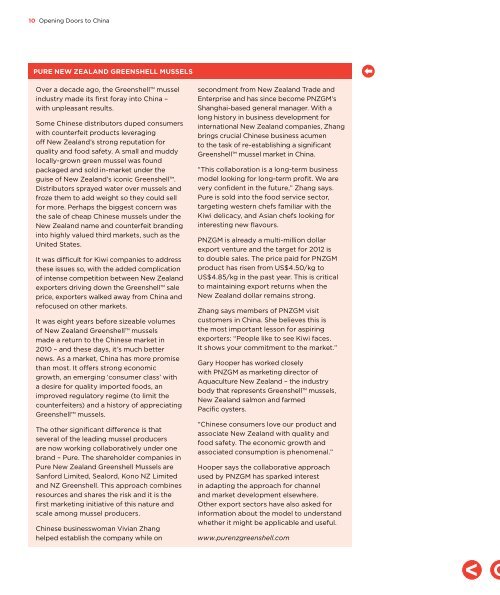Opening Doors to China : New Zealand's 2015 Vision - Te Puni Kokiri
Opening Doors to China : New Zealand's 2015 Vision - Te Puni Kokiri
Opening Doors to China : New Zealand's 2015 Vision - Te Puni Kokiri
- No tags were found...
Create successful ePaper yourself
Turn your PDF publications into a flip-book with our unique Google optimized e-Paper software.
10 <strong>Opening</strong> <strong>Doors</strong> <strong>to</strong> <strong>China</strong><strong>Opening</strong> <strong>Doors</strong> <strong>to</strong> <strong>China</strong> 11Pure <strong>New</strong> zealand Greenshell MusselsOver a decade ago, the Greenshell musselindustry made its first foray in<strong>to</strong> <strong>China</strong> –with unpleasant results.Some Chinese distribu<strong>to</strong>rs duped consumerswith counterfeit products leveragingoff <strong>New</strong> Zealand’s strong reputation forquality and food safety. A small and muddylocally-grown green mussel was foundpackaged and sold in-market under theguise of <strong>New</strong> Zealand’s iconic Greenshell.Distribu<strong>to</strong>rs sprayed water over mussels andfroze them <strong>to</strong> add weight so they could sellfor more. Perhaps the biggest concern wasthe sale of cheap Chinese mussels under the<strong>New</strong> Zealand name and counterfeit brandingin<strong>to</strong> highly valued third markets, such as theUnited States.It was difficult for Kiwi companies <strong>to</strong> addressthese issues so, with the added complicationof intense competition between <strong>New</strong> Zealandexporters driving down the Greenshell saleprice, exporters walked away from <strong>China</strong> andrefocused on other markets.It was eight years before sizeable volumesof <strong>New</strong> Zealand Greenshell musselsmade a return <strong>to</strong> the Chinese market in2010 – and these days, it’s much betternews. As a market, <strong>China</strong> has more promisethan most. It offers strong economicgrowth, an emerging ‘consumer class’ witha desire for quality imported foods, animproved regula<strong>to</strong>ry regime (<strong>to</strong> limit thecounterfeiters) and a his<strong>to</strong>ry of appreciatingGreenshell mussels.The other significant difference is thatseveral of the leading mussel producersare now working collaboratively under onebrand – Pure. The shareholder companies inPure <strong>New</strong> Zealand Greenshell Mussels areSanford Limited, Sealord, Kono NZ Limitedand NZ Greenshell. This approach combinesresources and shares the risk and it is thefirst marketing initiative of this nature andscale among mussel producers.Chinese businesswoman Vivian Zhanghelped establish the company while onsecondment from <strong>New</strong> Zealand Trade andEnterprise and has since become PNZGM’sShanghai-based general manager. With along his<strong>to</strong>ry in business development forinternational <strong>New</strong> Zealand companies, Zhangbrings crucial Chinese business acumen<strong>to</strong> the task of re‐establishing a significantGreenshell mussel market in <strong>China</strong>.“This collaboration is a long-term businessmodel looking for long-term profit. We arevery confident in the future,” Zhang says.Pure is sold in<strong>to</strong> the food service sec<strong>to</strong>r,targeting western chefs familiar with theKiwi delicacy, and Asian chefs looking forinteresting new flavours.PNZGM is already a multi-million dollarexport venture and the target for 2012 is<strong>to</strong> double sales. The price paid for PNZGMproduct has risen from US$4.50/kg <strong>to</strong>US$4.85/kg in the past year. This is critical<strong>to</strong> maintaining export returns when the<strong>New</strong> Zealand dollar remains strong.Zhang says members of PNZGM visitcus<strong>to</strong>mers in <strong>China</strong>. She believes this isthe most important lesson for aspiringexporters: “People like <strong>to</strong> see Kiwi faces.It shows your commitment <strong>to</strong> the market.”Gary Hooper has worked closelywith PNZGM as marketing direc<strong>to</strong>r ofAquaculture <strong>New</strong> Zealand – the industrybody that represents Greenshell mussels,<strong>New</strong> Zealand salmon and farmedPacific oysters.“Chinese consumers love our product andassociate <strong>New</strong> Zealand with quality andfood safety. The economic growth andassociated consumption is phenomenal.”Hooper says the collaborative approachused by PNZGM has sparked interestin adapting the approach for channeland market development elsewhere.Other export sec<strong>to</strong>rs have also asked forinformation about the model <strong>to</strong> understandwhether it might be applicable and useful.www.purenzgreenshell.com“It’s not really a case of identifying the potential. Thepotential is huge. The question is how we best convertthat potential in<strong>to</strong> real economic growth opportunitiesfor our country.”Prime Minister John KeyAtraxKevin Maurice says no exporter shouldbe paralysed by the fear of intellectualproperty infringement in <strong>China</strong>. He’s hadhis intellectual property (IP) s<strong>to</strong>len orthreatened in Germany, Singapore andeven in <strong>New</strong> Zealand, but through goodmanagement and good luck, he’s yet <strong>to</strong>have problems in <strong>China</strong>.Maurice set up design and manufacturecompany Atrax about 25 years ago. Hisweighing and measuring products aresold <strong>to</strong> other businesses which then installthem in airports around the world. Atraxproducts – from the small scales whichweigh your check-on baggage <strong>to</strong> the largescales used <strong>to</strong> weigh cargo for air freight– are in 101 countries from Iraq <strong>to</strong> ThePhilippines. One example is Hong KongInternational Airport, where every piece ofbaggage, freight or mail passing throughthe airport is routed over an Atrax scale.The company is well-positioned in <strong>China</strong><strong>to</strong> take advantage of the surging demandfor air travel and resultant expansionof airports across Asia. Atrax beganmanufacturing in <strong>China</strong> about three yearsago, after Maurice sold off the domesticarm of his business <strong>to</strong> focus on exporting.There were a number of issues <strong>to</strong> resolvebefore Maurice was comfortable with hisChinese operation.He found it <strong>to</strong>ok substantial effort <strong>to</strong>document his processes so he could relyon them being made <strong>to</strong> his standardsoffshore. He has now developed thedocumentation <strong>to</strong> ensure a consistentlyhigh standard, but he has also employedan engineering manager who spendsaround half his year in-market.Maurice also had <strong>to</strong> find a fac<strong>to</strong>ry, andfor this he relied on his networks. Heand another <strong>New</strong> Zealand businessowner have collaborated <strong>to</strong> establish afac<strong>to</strong>ry in southern <strong>China</strong> which fulfilsboth their needs. The businesses havecomplementary technology but are inunrelated industries.Finally, Maurice had <strong>to</strong> tackle the issue ofIP infringement. While ensuring he hasall the necessary registrations in place,Maurice has also taken a much moresimplistic approach. He has segmentedhis business so that there is little contactbetween the design capability in<strong>New</strong> Zealand, the manufacturing plantin southern <strong>China</strong> and the sales centre inShanghai. He routinely ships bulk goodsback <strong>to</strong> <strong>New</strong> Zealand where the productsare then loaded up with the software. And,whenever he uses a sub-contrac<strong>to</strong>r in<strong>China</strong>, he will ask them <strong>to</strong> make a piece ofsteel or electronic part but never divulgewhat it is for.“Some of these things are in conflictwith Western management styles but I’mthe only guy who knows all the parts ofthe jigsaw.”Maurice encourages other Kiwi businesspeople <strong>to</strong> reconsider <strong>China</strong> if they’vepreviously dismissed it as <strong>to</strong>o hard.“It is a big market. It is close <strong>to</strong> other partsof the world. Meanwhile, we are a far-flunglittle dot in the South Pacific. You can onlydo so much business from <strong>New</strong> Zealand.You need <strong>to</strong> get amongst it.”www.atraxgroup.com
















